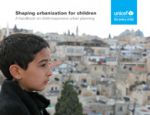Shaping urbanization for children: A handbook on child-responsive urban planning

This handbook is premised on the understanding that urbanization, the built environment, and spatial inequity affect children in important ways. For instance, 300 million children live in slums; though their experiences are very varied, they also differ significantly from children’s lives in formal environments.
Shaping urbanization for children operationalizes these factors by expounding 10 children’s rights and urban planning principles:
1) Cities should invest in child-responsive urban planning.
2) Cities should provide decent and affordable housing as well as secure land tenure.
3) Cities should ensure that children have access to public amenities.
4) Cities should provide safe, inclusive outdoor spaces for children.
5) Cities should have transportation systems that enable children’s mobility.
6) Cities should have integrated water and sanitation management systems.
7) Cities should have robust and accessible food systems.
8) Cities should develop sustainable waste cycle systems.
9) Cities should have reliable and sustainable energy networks.
10) Cities should have integrated data and ICT networks to ensure digital connectivity.
These are rather general, but the handbook includes conceptual information, evidence, tools, promising practices and excerpts from international frameworks to support the implementation of each principle. For instance, suggested metrics for Principle 5 (transportation) include the proportion of safe crossings, average commute time, rate of pedestrian fatalities, and process of implementing a road safety policy. For Principle 6 (water and sanitation), multiple SDG targets and a paragraph of the New Urban Agenda are quoted. One of the promising practices described under Principle 7 (food systems) is Kedai Balitaku in Jakarta, which supports food cart vendors to prepare more nutritious food and colourful carts that are more appealing to children.
Clearly, these 10 principles benefit adults as well. The handbook acknowledges the breadth of UNICEF’s intentions: “Convincing stakeholders that shaping cities for children is the best thing to do will benefit not only children, but all current and future citizens” (page 8). There is also an underlying aim of involving children in planning while making planning more child-friendly.
This is a practical guide, intended for urban planners, local governments, the private sector, and civil society organizations. It should help these varied actors to both make the case for child-responsive planning and begin to apply the compiled lessons. As a reference tool, full of diagrams, images and definitions, the book is perhaps most useful to individuals and organizations early in the process of incorporating children’s rights into planning—or interested in seeing their interconnections in practice.
Available from:
https://www.unicef.org/publications/index_103349.html
Further reading:
Bartlett, Sheridan (2008), “Climate change and urban children: impacts and implications for adaptation in low- and middle-income cities”, Environment and Urbanization Vol 20, No 2, pages 501–519, available at https://journals.sagepub.com/doi/pdf/10.1177/0956247808096125.
Cabannes, Yves (2006), “Children and young people build participatory democracy in Latin American cities”, Environment and Urbanization Vol 18, No 1, pages 195–218, available eat https://journals.sagepub.com/doi/pdf/10.1177/0956247806063973.
Environment and Urbanization (2002), “Building cities with and for children and youth”, Vol 14, No 2, available at https://journals.sagepub.com/toc/eaua/14/2.
Book note prepared by Christine Ro
Search the Book notes database
Our Book notes database contains details and summaries of all the publications included in Book notes since 1993 - with details on how to obtain/download.
Use the search form above, or visit the Book notes landing page for more options and latest content.
For a searchable database for papers in Environment and Urbanization, go to http://eau.sagepub.com/

